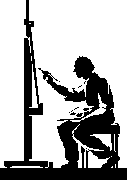Chapter 2 - Artwork Origination
(Sample page excerpted from book.)

Digital and optical based imaging systems are merging in the holography studio to produce visual displays that cannot be reproduced by either technology alone. The first section of this chapter will explain how computer graphic artists can use readily available computer hardware and software to generate “camera-ready” art suitable for holographic reproduction, and thereby expand their visual repertoire. It will also explore some related developments in the field of “computer-aided holography”.
Using Computers to Originate and Fabricate Holographic Imagery
It is now possible for computer-graphic artists using readily accessible hardware and software programs to electronically generate “camera-ready” artwork that holographers can assemble into images that display dimension, depth, projection and motion. Many holographers are substituting this digitally originated artwork in place of the time-consuming drawings, hard-to-record physical objects and expensive cinematic shoots that they traditionally utilized. They are using the computer to increase flexibility and versatility in the design and production processes, as well as to cut production costs. This merger between electronic imaging systems and optical-based ones is resulting in new and profitable opportunities for all those involved, especially the artists and designers that are able to best utilize both media to achieve their client’s goals.
In most instances, the “camera ready” artwork prepared by the design team is output as a series of computer graphics files which must be sent to a hologram origination facility. These computer files correspond to the various graphic elements of the holographic image being produced. In brief, the holographer uses these graphics files to generate a “master” hologram which is recorded on a high resolution photosensitive material using a CW laser and specialized optics. The master hologram can then be mass-replicated in a manner suitable for commercial applications.
In the future, we may see affordable desktop “holo-printers” that connect to any graphics workstation and produce finished holograms as easily as today’s computer printers output pages of paper. Several variations of these “instant” hologram machines are currently being developed by a handful of companies around the world. (The Business Directory in this book lists companies that manufacture and market these devices.)
The first part of this section will deal with image design and production techniques relating to the simplest, and most commonly requested type of hologram - - a 2D/3D embossed hologram. The second part of this section will discuss more complex holograms that are created using LCD screens, digitized imagery, computer generated animation programs and other computer graphic techniques.
Before we discuss the digital origination of holographic artwork in detail, we recommend that new readers review ....
